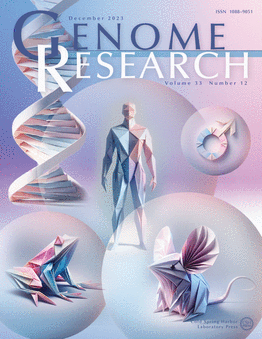Identification of the shortest species-specific oligonucleotide sequences
IF 6.2
2区 生物学
Q1 BIOCHEMISTRY & MOLECULAR BIOLOGY
引用次数: 0
Abstract
Despite the exponential increase in sequencing information driven by massively parallel DNA sequencing technologies, universal and succinct genomic fingerprints for each organism are still missing. Identifying the shortest species-specific nucleic sequences offers insights into species evolution and holds potential practical applications in agriculture, wildlife conservation, and healthcare. We propose a new method for sequence analysis termed nucleic "quasi-primes", the shortest occurring sequences in each of 45,785 organismal reference genomes, present in one genome and absent from every other examined genome. In the human genome, we find that the genomic loci of nucleic quasi-primes are most enriched for genes associated with brain development and cognitive function. In a single-cell case study focusing on the human primary motor cortex, nucleic quasi-prime genes account for a significantly larger proportion of the variation based on average gene expression. Non-neuronal cell types, including astrocytes, endothelial cells, microglia perivascular-macrophages, oligodendrocytes, and vascular and leptomeningeal cells, exhibited significant activation of quasi-prime containing gene associations related to cancer, while simultaneously suppressing quasi-prime containing genes were associated with cognitive, mental, and developmental disorders. We also show that human disease-causing variants, eQTLs, mQTLs and sQTLs are 4.43-fold, 4.34-fold, 4.29-fold and 4.21-fold enriched at human quasi-prime loci, respectively. These findings indicate that nucleic quasi-primes are genomic loci linked to the evolution of species-specific traits and in humans they provide insights in the development of cognitive traits and human diseases, including neurodevelopmental disorders.物种特异性最短寡核苷酸序列的鉴定
尽管在大规模并行DNA测序技术的推动下,测序信息呈指数级增长,但每种生物的通用和简洁的基因组指纹仍然缺失。确定最短的物种特异性核酸序列提供了对物种进化的见解,并在农业、野生动物保护和医疗保健方面具有潜在的实际应用。我们提出了一种新的序列分析方法,称为核酸“准引物”,即在45,785个生物体参考基因组中出现的最短序列,存在于一个基因组中,而不存在于其他所有被检查的基因组中。在人类基因组中,我们发现与大脑发育和认知功能相关的基因在核酸准引物的基因组位点中最为丰富。在一项针对人类初级运动皮层的单细胞案例研究中,基于平均基因表达的变异中,核准主要基因占比明显更大。非神经元细胞类型,包括星形胶质细胞、内皮细胞、小胶质血管周围巨噬细胞、少突胶质细胞、血管细胞和轻脑膜细胞,显示出与癌症相关的准起始基因的显著激活,同时抑制与认知、精神和发育障碍相关的准起始基因。我们还发现,人类致病变异、eqtl、mqtl和sqtl分别在人类准prime位点富集4.43倍、4.34倍、4.29倍和4.21倍。这些发现表明,核准引物是与物种特异性特征进化相关的基因组位点,在人类中,它们为认知特征和人类疾病(包括神经发育障碍)的发展提供了见解。
本文章由计算机程序翻译,如有差异,请以英文原文为准。
求助全文
约1分钟内获得全文
求助全文
来源期刊

Genome research
生物-生化与分子生物学
CiteScore
12.40
自引率
1.40%
发文量
140
审稿时长
6 months
期刊介绍:
Launched in 1995, Genome Research is an international, continuously published, peer-reviewed journal that focuses on research that provides novel insights into the genome biology of all organisms, including advances in genomic medicine.
Among the topics considered by the journal are genome structure and function, comparative genomics, molecular evolution, genome-scale quantitative and population genetics, proteomics, epigenomics, and systems biology. The journal also features exciting gene discoveries and reports of cutting-edge computational biology and high-throughput methodologies.
New data in these areas are published as research papers, or methods and resource reports that provide novel information on technologies or tools that will be of interest to a broad readership. Complete data sets are presented electronically on the journal''s web site where appropriate. The journal also provides Reviews, Perspectives, and Insight/Outlook articles, which present commentary on the latest advances published both here and elsewhere, placing such progress in its broader biological context.
 求助内容:
求助内容: 应助结果提醒方式:
应助结果提醒方式:


